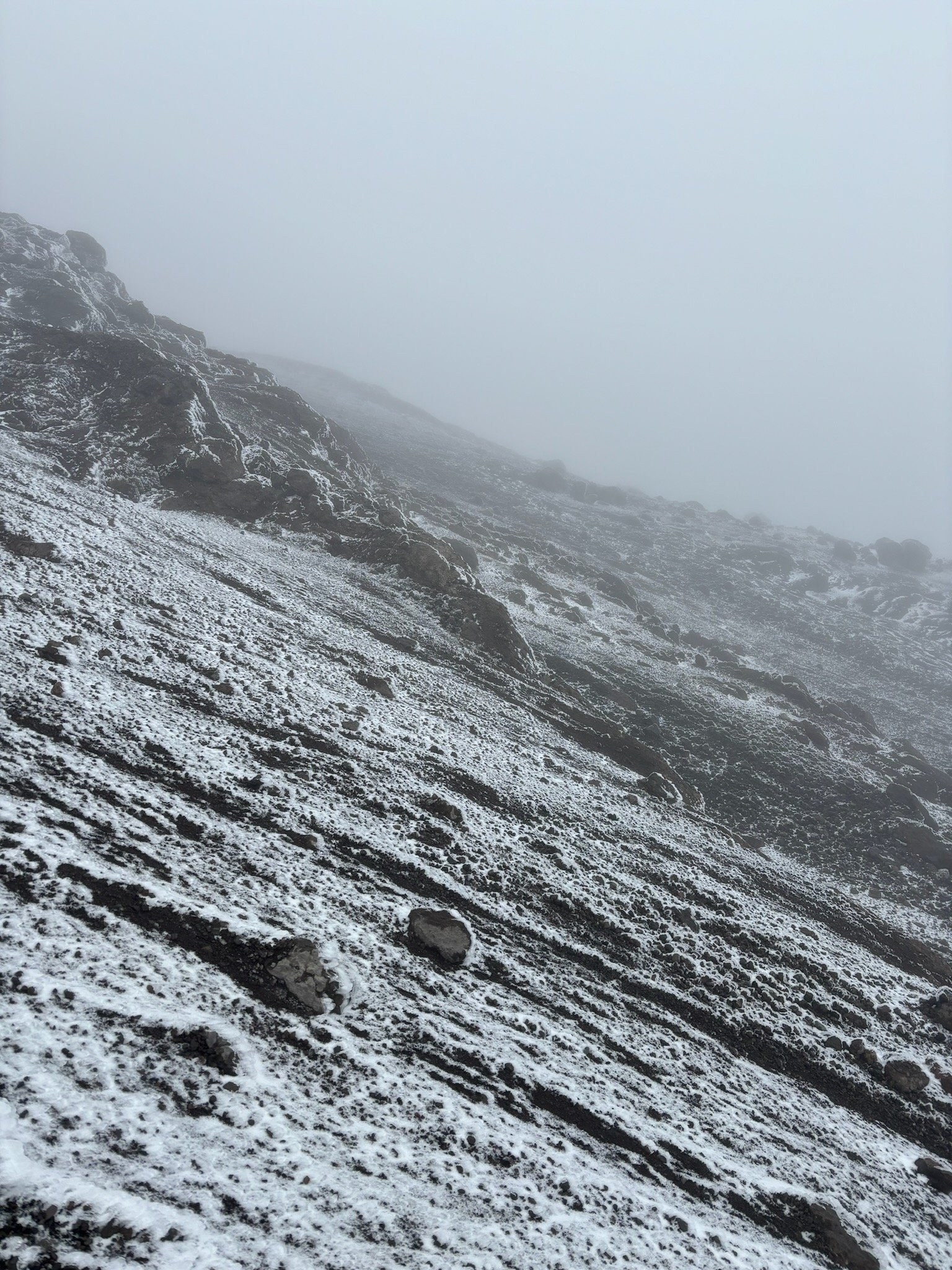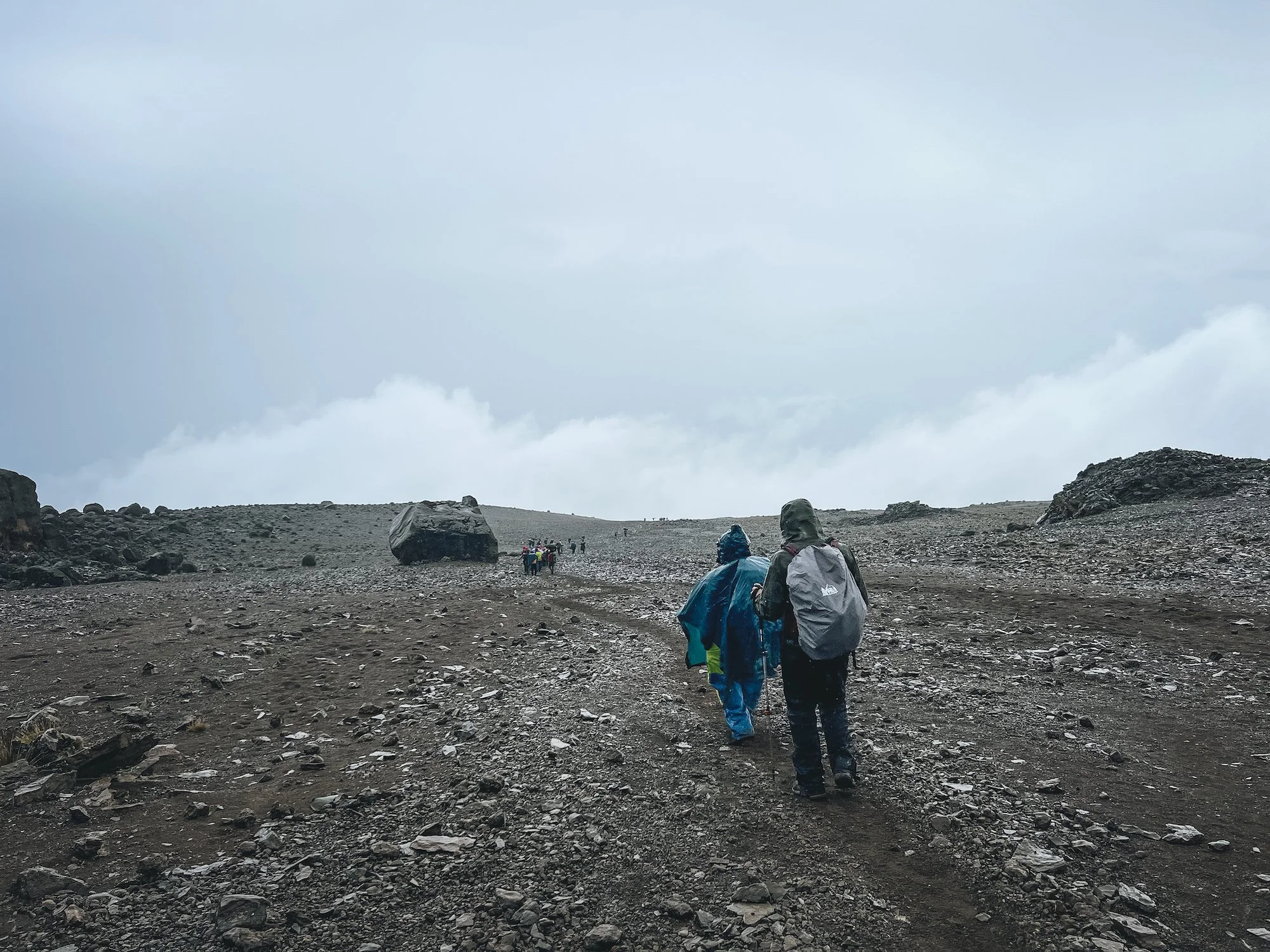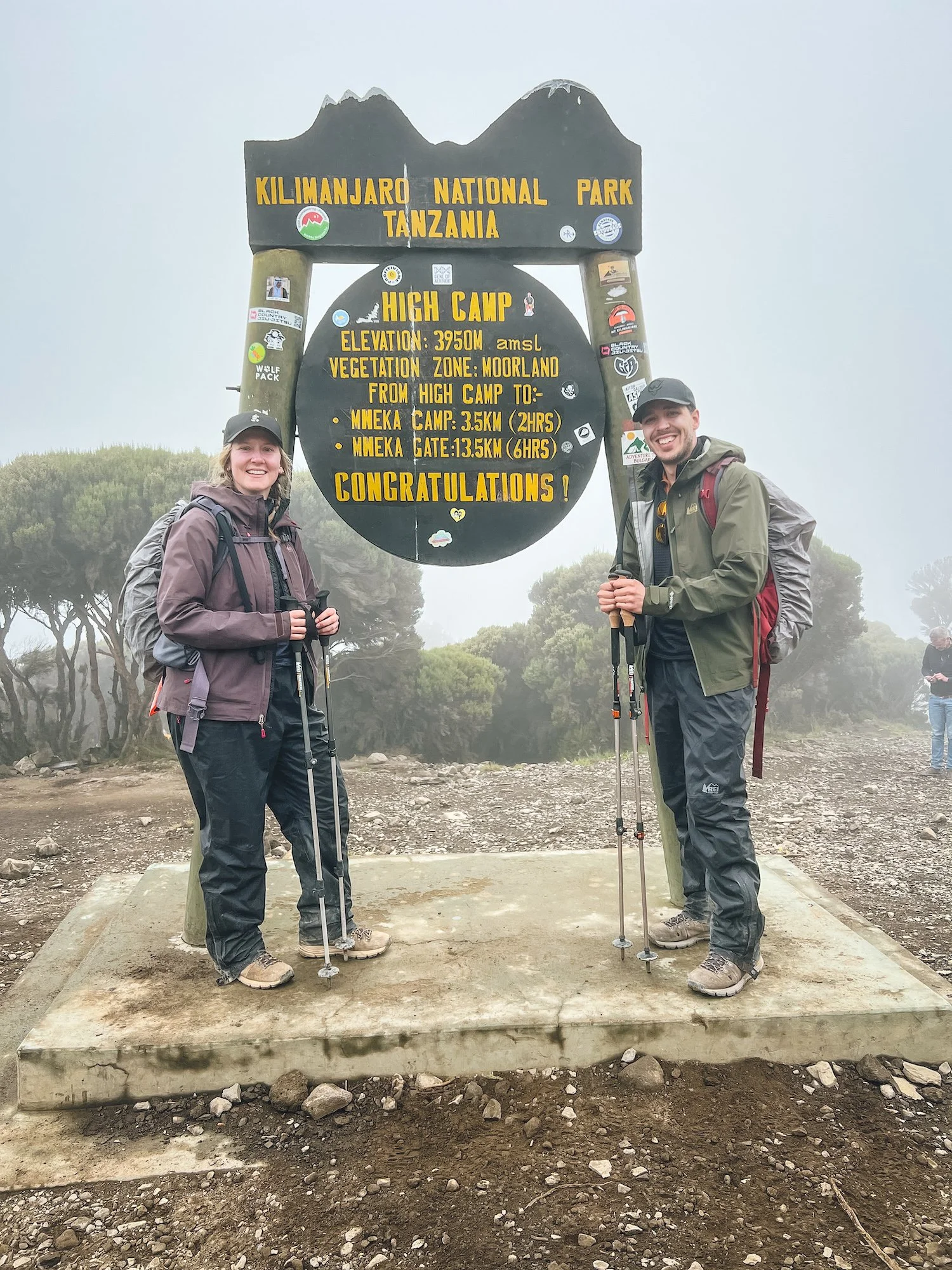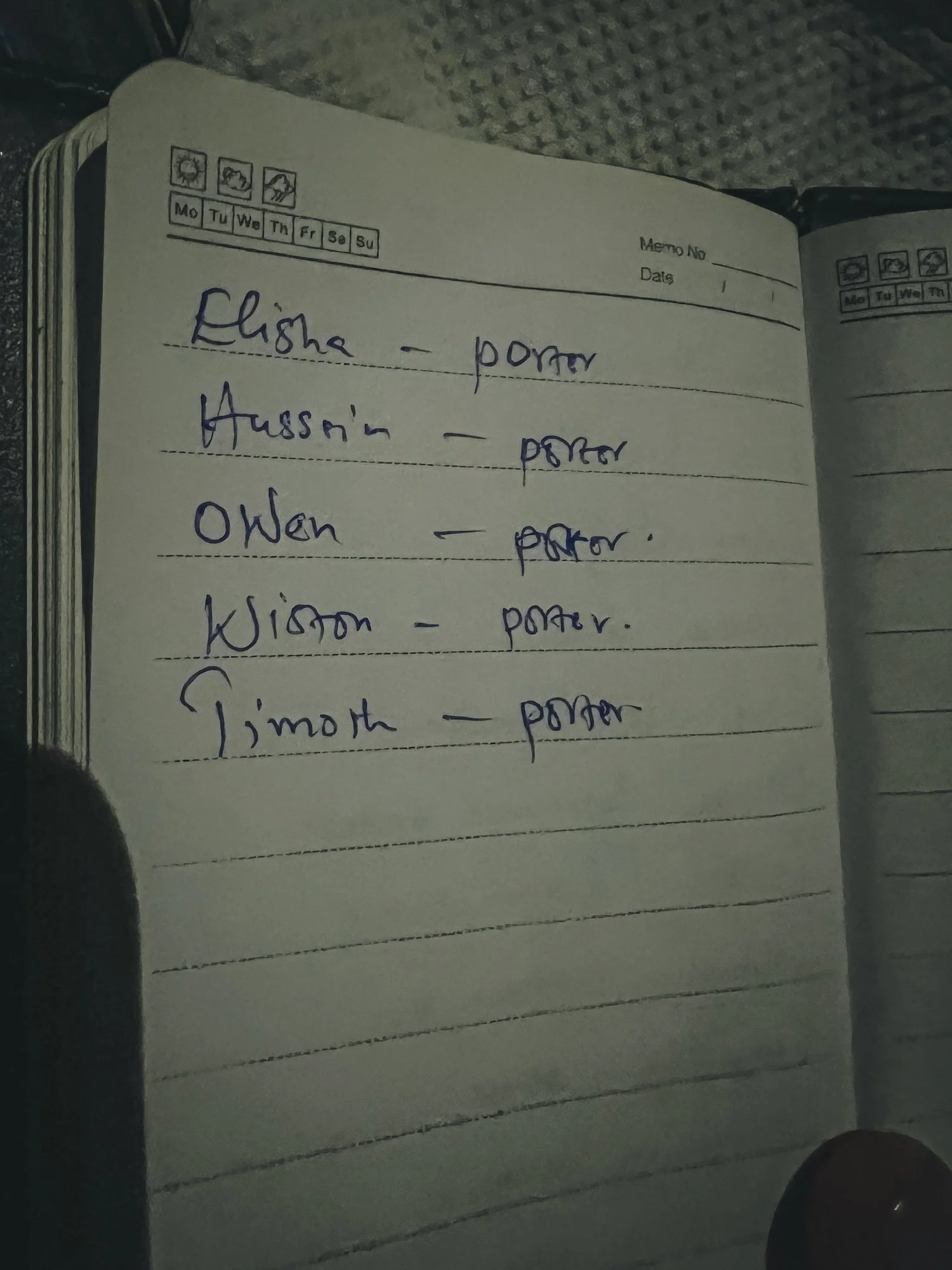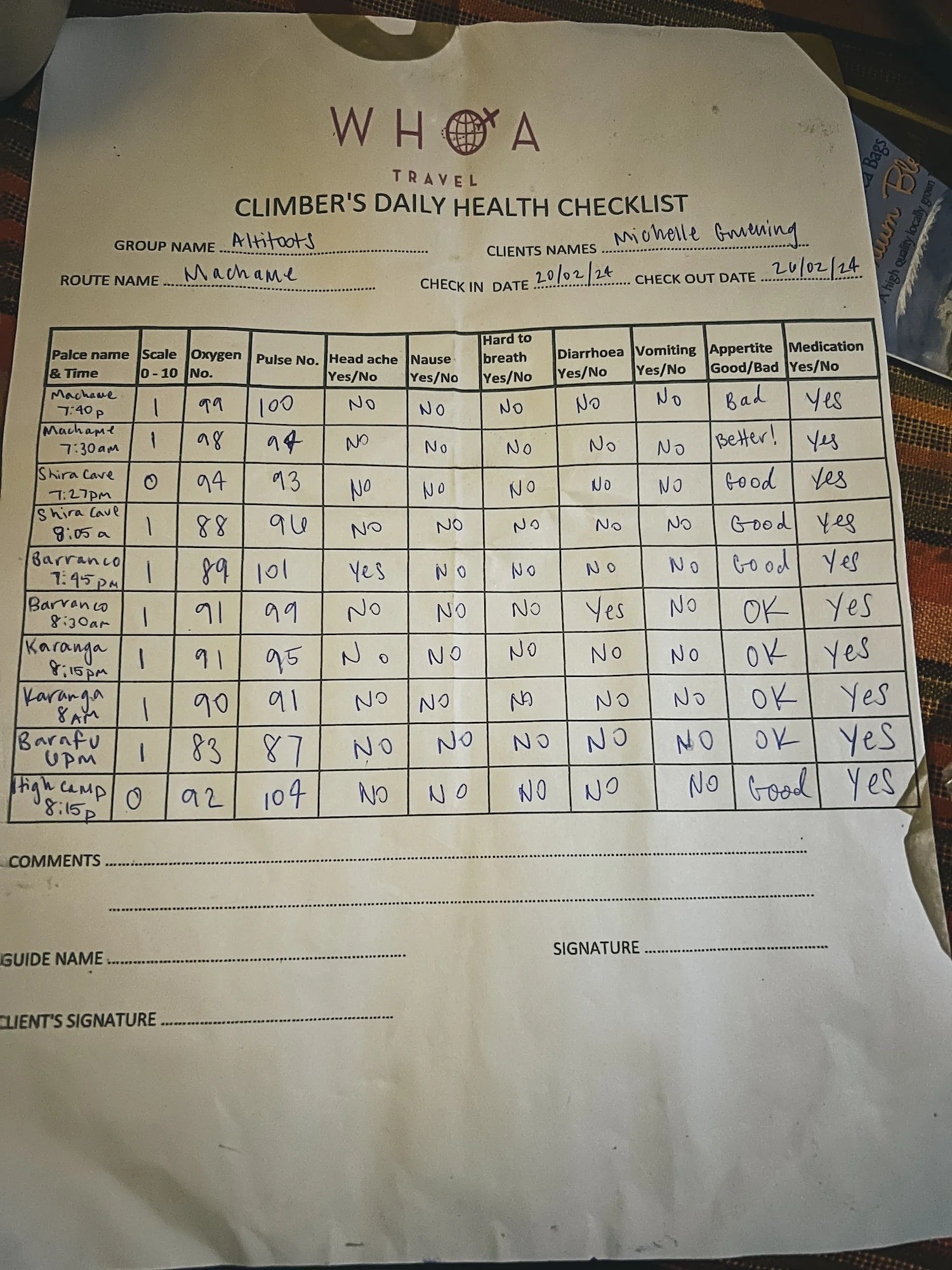Climbing Kilimanjaro - Day 6, Part Two
We made it to the summit of Mount Kilimanjaro! After a year of training and preparation, we stood on the summit of the world’s tallest freestanding mountain. Fifteen minutes after we arrived at the summit, it was time to start our descent. We didn’t spend long at the top for a few reasons: we were above 19,000 feet with oxygen levels at a minimum, we were frozen and covered in ice, and we still had a long day of hiking ahead of us.
Back to Base Camp
As we started the hike down the mountain, the icy rain and wind had slowed down enough that the ice layers slowly began to melt off our bodies. I was able to remove a chunk of ice from Danny’s head in a perfect helmet shape – it was a great moment of levity. By this time I was starting to feel a headache from the pressure of wearing a balaclava, beanie, and headlamp, so Abuu graciously, if not gently, pried the frozen headlamp away from my beanie and off my head.
We stopped for another rest at Stella Point, but I hoped it wouldn’t be a long one because at this point breaks weren’t reenergizing me, but draining me. My water bladder was still completely frozen, so I drank from the still liquid portion of my Nalgene that Bakari was carrying. As we rested and were no longer fighting for every breath on our push to the summit, we were able to take stock of how truly ice covered we were. Each of our hiking poles were encased in a perfect cylinder of ice, and the zippers to my fanny pack were frozen shut. Our eyelashes were snow frosted and us ladies had some incredible ice ornaments hanging off the long hairs that escaped our beanies. I didn’t want to rip the ice off my hair (my highlighted hair is damaged enough) so I would wrap my hand around my personal icicles for a few minutes to help it thaw.
We found the trail that would lead us back down the way we came, and it was amazing to see the landscape in the daylight. There was still a lingering fog that colored everything in neutral blacks and whites but we could see the environment starting to take shape around us. The mountainside we were on was steep, which is why the trail had so many switchbacks. We could see the wind continuing to blow across the mountain, moving snow and dirt throughout the air.
The landscape during the majority of our descent. This image does not have any filter on it, it was truly black and white.
We walked in a group for a while before Danny and I broke off in the front with Abuu, as our pace was a bit faster. We hiked down all the switchbacks and the trails got softer as we continued our descent. The trail was so soft at times that I was almost skating or gliding down it instead of walking. There were times when the trail stiffened up and I could do a light jog for a short section, which felt better on my knees but didn’t help my lightheadedness. It was around this time we realized how far ahead we had gotten from Kim and Katie, although we could still see them behind us with LuLu. Abuu told us to continue following him down the trail, and as we did his pace was so much faster than ours that he would end up 100 feet ahead of us and wait until we caught up.
Barren Landscape and Bare Bottoms
A couple hours into our descent I had to pee for the first time since we left camp earlier that day (hello dehydration). At this point, there was nothing around but frozen ground and a few boulders off the trail. I found a large boulder and did my best to shield myself from my fellow hikers, which was a challenge based on how the trail cut through the mountain. Relieved from the pressure of a full bladder, and only losing a small amount of toilet paper to the wind, Danny and I continued following Abuu down the mountain.
We came to an area of the trail where there were a couple large rock walls and saw a group of porters standing there. I was so distracted that at first I didn’t realize they were our porters meeting us along the trail to take our packs and continue shepherding us down the mountain. That’s right, the porters once again climbed a couple hours up the mountain to meet us and walk us back down – they are amazing! At this point, Danny and I were taken ahead by two of the porters, neither of which spoke much English so it was a quieter hike. Abuu waited with the other porters for Kim, Katie, and LuLu. He told us to rest when we got to camp, but not to go to sleep as we still had more hiking ahead of us.
Continuing toward base camp, our porters would help break ice off of us and stop whenever we needed a water break, or rather whenever we wanted to check whether our water was still frozen (it was). Ice kept falling off in chunks from our bags, our poles, and our bodies as we descended farther down the mountain, leaving us soaking wet.
The dirt trail soon led into rocky terrain with large steps down that took much more focus and energy than I had to spare. With my hiking poles working overtime and a helping hand from the porters, we made it through the rocky section and arrived at Kosovo Camp. We remembered that Kosovo Camp was pretty close to Base Camp, and I held onto the knowledge that I could soon lie down inside our tent.
Who's Touching My Feet?
We arrived at the top of Base Camp and had to go a bit further to get to our little tent village. We had hiked around that area a couple of times so we knew what direction we were going, but the porters started taking us even farther down the mountain. Danny and I looked at each other with eyes of “WTF, where are we going!” but we didn’t want to question our professional porters. They had brought us to the bottom of our tent village, and our personal tents were at the top. That meant climbing back UP. My legs have never felt so heavy and useless as they did when I had to climb 15 feet up a hill to get into our area. But we made it, and I was never so excited to see our crumbling tent.
As soon as we got there, there were several porters cheering for us and giving out high fives, congratulating us on a mission well accomplished. They quickly took our bags and got our tent unzipped for us to crash into. I immediately laid down on my back inside the tent with my boots sticking out so all the dirt and snow and dust wouldn’t get inside. I felt my boots being unlaced and thought it was Danny, so I said, “Oh thanks babe!”, to which he replied, “That’s not me.” With a bit of a laugh I sat up to see our sweet porter, Frank, getting my boots off for me to clean them a up a bit before setting them back outside the tent.
Feet free of boots, Jimmy handed us mugs of mango juice that I honestly didn’t know what to do with at the time. I just held it while sitting in the tent, staring into the walls in a bit of a daze. Once we got the tent zipped back up I started the process of shedding layers and stick-on heat pads. I removed my hiking pants, a pair of base layer tights, my mountaineering socks, and about four layers from my top. We were told not to go to sleep, but that we could rest for a while until it was time for lunch. I’m not sure if I actually fell asleep or not, but those few moments of stillness (well, as much stillness as the ever present freaking wind would grant us) were reinvigorating.
Descending To Our Final Camp
While we were eating lunch, Abuu gave us the option to go to the next closest camp (High Camp, also known as Millenium Camp) or continue past it to Mweka Camp. We all swiftly agreed to stop at the first camp, not wanting to go further than absolutely necessary after such an exhausting day.
We had a small lunch at Base Camp and swapped stories about the summit push that morning and our descent back to camp. It was still so windy that we were ready to get out of the constant noise, so we got our duffels repacked and our layers back on for the descent to our final camp of the trek. As we were descending out of Base Camp, we passed by dozens more groups either wrapping up their summit day or getting set up for their summit attempt later that night. I was very glad at the spot our guides chose to set up our tents at Base Camp, because some groups were located at the bottom of camp near the helipad, at least a half mile away from the start of the trail.
We once again got split up during this last push, with LuLu leading Danny and I in the front, our pace set to extra fast. We got down the steepest section coming out of base camp then it was a fairly cruisey stretch across a giant slate field. I remember thinking, “Man this slate could make so many yard pavers.” It was pretty incredible to see this landscape – rocky, sharp, an ever increasing pile of slate. We passed by a pile of what looked like overturned shopping carts on a large wheel, and as we got closer we realized that wasn’t far off from what they were. LuLu told us these were used to aid people down the mountain in case of injury or emergency. Picture a metal basket the shape of a rectangle, about six feet long and a couple feet wide, with one wheel on the bottom center. Whenever they’re needed, several porters would surround the makeshift gurney and wheel the injured person down the mountain. I can imagine that it is anything but a smooth ride.
The Fog Returns
Losing altitude with every step, flowers and plants returned to the landscape and small streams trickled nearby. We were well ahead of the rest of the group at this point, with them somewhere in the fog behind us, so we kept pushing forward to camp. It took a couple hours to get from Base Camp to High Camp, and once we saw the sign appear out of the fog I felt I could cry from happiness. We decided to sit on a bench at the ranger station to wait a bit for Kim and Katie so we could take our group picture. While we were waiting, we met a group we’d seen several times along the trail – a group of hikers from the UK in their 60s and older, all of whom had made it to the top successfully. We traded stories and tales from our summit successes, and celebrated each other’s incredible victories.
After 15 minutes or so, we decided to get a picture of just Danny and I with the sign and that we’d do a group picture the next morning. As we made our way into the trees where our tents were set up, the pied crows were once again scavenging the area for food.
Day Six, complete!
Arriving at camp we were pleased to see the toilet tent was back to its original level of tautness and that the zipper flowed smoothly to open and close it – no more close calls for us! In our tent we changed into our camp clothes for the final time and organized our things for the last night of the trek. Katie graciously loaned us her portable charger so Danny and I could charge our phones, as our portable charger had died earlier in the day. We also dipped back into Kim and Katie’s pain killer stash, ours having run out a couple days earlier. We were prepared in a lot of ways, but not these two ways. All settled and changed, we reconvened for snacks and tea in the mess tent.
We were expecting popcorn but got toasted peanuts instead, which was a fun mixup from our usual snacks. We continued reliving the day and everything we felt along the way to the summit. Now that we had all successfully summited Kilimanjaro, we wanted to know – did anyone have any doubts that they were going to make it? Turns out, all of us doubted ourselves at one point or another along the summit climb, questioning whether we would be able to make it. Thankfully, we all kept those concerns to ourselves in the moment and we all pushed forward.
Google Can Translate
I brought thank you cards so that we could write a little something to our porters and include their tips inside. We asked Abuu to write down all of the porters' names so that we could address them properly, and he helped us understand which porters should get a higher tip than others based on their duties. For example, the porters who went with us to the summit, the waiter, and the toilet manager were all on the list for an extra few dollars. Katie translated a message from English to Swahili using Google Translate, and we each took a stack of cards to write our message into. The message read:
Asante kwa ukarimu na utunzaji wako – hatukuweza kilele cha Kilimanjaro bila wewe!
Which in English translates to, “Thank you for your hospitality and care – we could not have summited Kilimanjaro without you!”
We at least hoped it translated in a form of Swahili that was understandable by our incredible crew, and we filled out the last of the cards. From what I remember we all ate a substantial amount of dinner, our first night of feeling truly ready for food. We stayed up for a while laughing, celebrating, and in amazement of ourselves.
Abuu and LuLu came into the tent at 8:15pm for one final health check, where my blood oxygen was at 92 and my heart rate was at 104 (the highest of the whole trip). They gave us praise and congratulations, and we got talking a bit about the other groups along the way. Abuu told us that the day we were hiking from Karanga Camp to Base Camp (Day Five), there was a hiker at Lava Tower Camp (where we had our acclimation lunch on Day Three) that started feeling terribly ill. The wind was so bad that day the helicopters could not safely get to camp and the hiker died of a pulmonary embolism before he could be rescued. This was such devastating news to hear, and a harsh reminder that there are real dangers to climbing Kilimanjaro.
With that heavy news and a slight rain starting to drop from the sky, we said our goodnights and got ourselves ready for bed. As I’ve mentioned, our tent was a bit worn, so we shoved our towels in the more water-prone spots and pulled all our gear away from the sides. Tucked into our sleeping bags, the rain was picking up and created a perfect layer of white noise to send us off into a solid, restful, final night of sleep on Kilimanjaro.
Day Six, Part Two Stats
Day Six starting elevation at Barafu Camp: 15,091 feet
Day Six elevation at Uhuru Peak, the summit of Mount Kilimanjaro: 19,341 feet
Day Six ending elevation at High Camp: 12,467 feet
Total hiking distance: 10 miles (3 miles up, 7 miles down), 4248 feet of elevation gain, 6874 feet descent
Highs and Lows
A nightly tradition during dinner was to share our Highs and Lows for the day. It was always a fun way to recap the day and see what everyone took away from it. Sometimes one person’s Low was another person’s High. I’ll share my own Highs and Lows for each day at the end of every blog post.
Day Six Low: feeling wiped and completely off when we reached Stella Point, the moment I doubted whether I was going to make it to Uhuru Peak
Day Six High: getting myself into flow state during the summit climb, and of course reaching the summit of Mount Kilimanjaro!
Health Checks
Morning Check at 12am - Blood oxygen: 80ish | Heart rate: 90ish
Evening Check at 8:15pm - Blood Oxygen: 92 | Heart rate: 104
Note To Reader
If you are reading this purely for entertainment, awesome! This disclaimer does not apply to you. If you are reading this in preparation for your own climb of Kilimanjaro, it’s important for me to note the following things. Before my climb of Kilimanjaro:
I was living in Colorado at an elevation of 5350 feet above sea level
I was in excellent physical condition and was 36 years old
I did not smoke, rarely drank alcohol and did not have any for two months prior to the trip, and did not have any other medical issues
I had been hiking to elevations above 12,000 feet for years and hiked in the mountains every weekend for three months before the trek
I physically trained for a year before my trek through cardio and weight training at OrangeTheory Fitness
I had a lot of gear already, although I did purchase a lot
Why do I include this information? Because research will be a part of your trip preparation and you’ll most likely read a lot of blog posts like this. A trend that I saw in my own research was that people didn’t include their personal background before giving advice or recaps of their own trip. To best understand my experience, I want to give you a basic understanding of me as a human, and the benefits I had before embarking on this journey. This may help you better prepare for and relate to the experiences I had along the trail.

